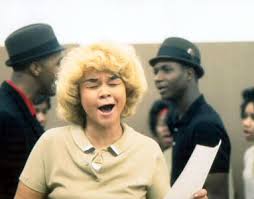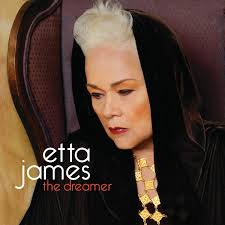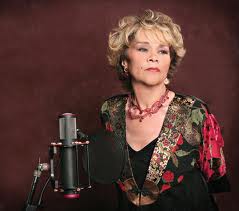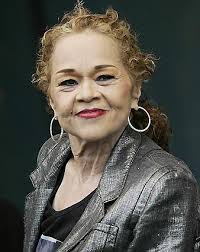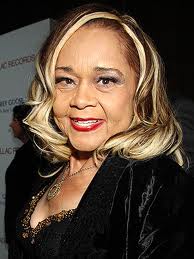Etta James
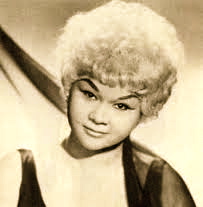
Etta James Story (Part 1-6)
This is a (6) part documentary on the life and career of my dear friend Etta James. Each video is 30 minutes in length totaling 3 hours filled with music plus interviews I conducted with people who performed with or were inspired by Miss Peaches. Part: 1 examines the career of Etta James from 1954 to 1955 including music plus interviews with Etta James, Ruth Brown, Wilson Pickett, Johnny Otis, Buddy Guy and Phillip Walker.
 Etta James (born Jamesetta Hawkins January 25, 1938- died January 20, 2012)
Etta James (born Jamesetta Hawkins January 25, 1938- died January 20, 2012)
Was an American singer. Her style spanned a variety of music genres including blues, R&B,soul, rock and roll, jazz and gospel. Starting her career in 1954, she gained fame with hits such as “The Wallflower“, “At Last“, “Tell Mama“, “Something’s Got a Hold on Me“, and “I’d Rather Go Blind” for which she wrote the lyrics. She faced a number of personal problems, including drug addiction, before making a musical resurgence in the late 1980’s with the album Seven Year Itch.
James is regarded as having bridged the gap between rhythm and blues and rock and roll, and is the winner of six Grammys and 17 Blues Music Awards. She was inducted into the Rock and Roll Hall of Fame in 1993, the Blues Hall of Fame in 2001, and the Grammy Hall of Fame in both 1999 and 2008. Rolling Stone ranked James number 22 on their list of the 100 Greatest Singers of All Time and number 62 on the list of the 100 Greatest Artists.
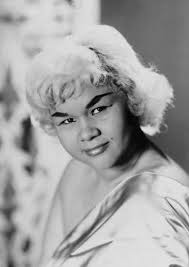 Early life and career: 1938–1959
Early life and career: 1938–1959
Jamesetta Hawkins was born on January 25, 1938, in Los Angeles, California, to Dorothy Hawkins, who was only 14 at the time. Her father has never been identified. James speculated that her father was the pool player Rudolf “Minnesota Fats” Wanderone, and met him briefly in 1987. Due to her mother being often absent from their Watts apartment, conducting relationships with various men, James lived with a series of foster parents, most notably “Sarge” and “Mama” Lu. James referred to her mother as “the Mystery Lady.”
James received her first professional vocal training at the age of five from James Earle Hines, musical director of the Echoes of Eden choir, at the St. Paul Baptist Church in south central Los Angeles. She became a popular singing attraction at the church, and Sarge tried to pressure the church into paying him money for her singing, but they refused. During drunken poker games at home, he would often wake James up in the early hours of the morning and force her through beatings to sing for his friends. As she was a bed-wetter, and often soaked with her own urine on these occasions, the trauma of being forced to sing meant she had a lifelong reluctance to sing on demand.
In 1950, Mama Lu died, and James’ real mother took her to the Fillmore District, San Francisco. Within a couple of years, James began listening to doo-wop and was inspired to form a girl group, called the Creolettes (due to the members’ light skinned complexions). The 14-year-old girl met musician Johnny Otis. Stories on how they met vary including Otis’ version in which James had come to his hotel after one of his performances in the city and persuaded him to audition her. Another story came that Otis spotted the group performing at a Los Angeles nightclub and sought them to record his “answer song” to Hank Ballard‘s “Work with Me, Annie.” Nonetheless, Otis took the group under his wing, helping them sign to Modern Records and changing their name from the Creolettes to the Peaches and gave the singer her stage name reversing Jamesetta into Etta James. James recorded the version, which she was allowed to co-author, in 1954, and the song was released in early 1955 as “Dance with Me, Henry.” Originally the name of the song was “Roll With Me, Henry” but was changed to avoid censorship due to the subtle title. In February of that year, the song reached number one on the Hot Rhythm & Blues Tracks chart. Its success gave the group an opening spot on Little Richard‘s national tour.
While on tour with Richard, pop singer Georgia Gibbs recorded her version of James’ song, which was released under the title “The Wallflower”, and became a crossover hit, reaching number one on the Billboard Hot 100, which angered James. After leaving the Peaches, James had another R&B hit with “Good Rockin’ Daddy”, but struggled with follow-ups. When her contract with Modern came up in 1960, she decided to sign with Leonard Chess‘ namesake label, Chess Records, and shortly afterwards got involved in a relationship with singer Harvey Fuqua, founder of the doo-wop group, The Moonglows.
Bobby Murray, aka “Taters”, toured with Etta James for 20 years. He wrote that James had her first hit single when she was 15 years of age and went steady with B.B. King when she was 16. Etta James believed the hit single “Sweet Sixteen” by King was about her.
Dueting with Harvey Fuqua, James recorded for the Chess label Argo (later Cadet) and her first hit singles with Fuqua were “If I Can’t Have You” and “Spoonful.” Her first solo hit was the doo-wop styled rhythm and blues number, “All I Could Do Was Cry,” becoming a number two R&B hit.Leonard Chess had envisioned James as a classic ballad stylist who had potential to cross over to the pop charts and soon surrounded the singer with violins and other string instruments. The first string-laden ballad James recorded was “My Dearest Darling” in May 1960, which peaked in the top five of the R&B chart. James sang background vocals on label mate Chuck Berry‘s “Back in the U.S.A.“
Her debut album, At Last!, was released in late 1960 and was noted for its varied choice in music from jazz standards to blues numbers to doo-wop and rhythm and blues (R&B). The album also included James’ future classic, “I Just Want to Make Love to You” and “A Sunday Kind of Love“. In early 1961, James released what was to become her signature song, “At Last,” which reached number two on the R&B chart and number 47 on the Billboard Hot 100. Though the song was not as successful as expected, it has become the most remembered version of the song. James followed that up with “Trust in Me,” which also included string instruments. Later that same year, James released a second studio album, The Second Time Around. The album took the same direction as her previous album, covering many jazz and pop standards, and using strings on many of the songs spawning two hit singles, “The Fool That I Am” and “Don’t Cry Baby.”
 James started adding gospel elements in her music the following year releasing “Something’s Got a Hold on Me”, which peaked at number four on the R&B chart and was also a top 40 pop hit. That success was quickly followed by “Stop the Wedding”, which reached number six on the R&B charts and also had gospel elements. In 1963, she had another major hit with “Pushover” and released the live album Etta James Rocks the House, which was recorded at the New Era Club in Nashville, Tennessee. After a couple years scoring minor hits, James’ career started to suffer after 1965. After a period of isolation, James returned to recording in 1967 and reemerged with more ballsy R&B numbers thanks to her recording at the legendary Fame Studios in Muscle Shoals, Alabama releasing her comeback hit “Tell Mama”, which was co-written by Clarence Carter and Paul C Saenz, and reached number ten R&B and number twenty three pop. An album of the same name was also released that year and included her take of Otis Redding‘s “Security.” The B-side of “Tell Mama” was “I’d Rather Go Blind“, which became a blues classic in its own right and was recorded by many other artists. She wrote in her autobiography Rage To Survive that she heard the song outlined by her friend Ellington “Fugi” Jordan when she visited him in prison. According to her account, she wrote the rest of the song with Jordan, but for tax reasons gave her songwriting credit to her partner at the time, Billy Foster.
James started adding gospel elements in her music the following year releasing “Something’s Got a Hold on Me”, which peaked at number four on the R&B chart and was also a top 40 pop hit. That success was quickly followed by “Stop the Wedding”, which reached number six on the R&B charts and also had gospel elements. In 1963, she had another major hit with “Pushover” and released the live album Etta James Rocks the House, which was recorded at the New Era Club in Nashville, Tennessee. After a couple years scoring minor hits, James’ career started to suffer after 1965. After a period of isolation, James returned to recording in 1967 and reemerged with more ballsy R&B numbers thanks to her recording at the legendary Fame Studios in Muscle Shoals, Alabama releasing her comeback hit “Tell Mama”, which was co-written by Clarence Carter and Paul C Saenz, and reached number ten R&B and number twenty three pop. An album of the same name was also released that year and included her take of Otis Redding‘s “Security.” The B-side of “Tell Mama” was “I’d Rather Go Blind“, which became a blues classic in its own right and was recorded by many other artists. She wrote in her autobiography Rage To Survive that she heard the song outlined by her friend Ellington “Fugi” Jordan when she visited him in prison. According to her account, she wrote the rest of the song with Jordan, but for tax reasons gave her songwriting credit to her partner at the time, Billy Foster.
Following this success, James became an in-demand concert performer though she never again reached the heyday of her early to mid-1960s success. She continued to chart in the R&B Top 40 in the early 1970’s with singles such as “Losers Weepers” (1970) and “I Found a Love” (1972). Though James continued to record for Chess, she was devastated by the death of Chess founder Leonard Chess in 1969. James ventured into rock and funk with the release of her self-titled album in 1973 with production from famed rock producer Gabriel Mekler, who had worked with Steppenwolf and Janis Joplin, who had admired James and had covered “Tell Mama” in concert. The album, known for its mixtures of musical styles, was nominated for a Grammy Award. The album did not produce any major hits, neither did the follow-up, Out On the Street Again, in 1974, though like Etta James before it, the album was also critically acclaimed. James continued to record for Chess releasing two more albums in 1978, Etta Is Betta Than Evah and Deep in the Night, which saw the singer incorporating more rock-based music in her repertoire. That same year, James was the opening act for The Rolling Stones and also performed at the Montreal International Jazz Festival. Following this brief success, however, she left Chess Records and did not record for another ten years as she struggled with drug addiction and alcoholism.
Though she continued to perform, little was heard of Etta James until 1987 when she was seen performing “Rock & Roll Music” with Chuck Berry on his “Hail! Hail! Rock ‘n’ Roll” documentary. In 1989, James signed with Island Records and released the album Seven Year Itch. The album was produced by Barry Beckett. She released a second album, also produced by Barry Beckett, in 1989 titledStickin’ to My Guns. Both albums were recorded at FAME Studios. Also in 1989 James filmed a live concert from the Wiltern Theater in Los Angeles with Joe Walsh and Albert Collins, “Jazzvisions: Jump The Blues Away”. Backing musicians consisted of many top-flight players from LA: Rick Rosas (bass); Michael Huey (drums); Ed Sanford (B3); Kip Noble (piano); and Etta’s longtime guitar player Josh Sklar (guitar). James participated in rap singer Def Jef for the song “Droppin’ Rhymes on Drums,” which mixed James’ jazz vocals with hip-hop. In 1992, James released The Right Time produced by Jerry Wexler on Elektra Records and the following year, James was inducted into the Rock and Roll Hall of Fame. James signed with Private Music Records in 1993 and recorded the Billie Holiday tribute album Mystery Lady: Songs of Billie Holiday. The album later set a trend for James’ music to incorporate more jazz elements. The album won James her first Grammy Award for best jazz vocal performance in 1994. In 1995, she released the David Ritz-co authored autobiography, A Rage to Survive, and recorded the album Time After Time. Three years later she issued the Christmas album Etta James Christmas in 1998.
By the mid-1990’s, James’ earlier classic music was included in commercials including, most notably, “I Just Wanna Make Love to You.” Due to exposure of the song in a UK commercial, the song reached the top ten of the UK charts in 1996. Continuing to record for Private Music, she released the blues album Matriarch of the Blues in 2000, which had James returning to her R&B roots with Rolling Stone hailing it as a “solid return to roots”, further stating that the album found the singer “reclaiming her throne—and defying anyone to knock her off it.” In 2001, she was inducted into the Blues Hall of Fame and the Rockabilly Hall of Fame, the latter for her contributions to the developments of both rock and roll music and rockabilly. In 2003, she received a Grammy Lifetime Achievement Award. Her 2004 release, Blue Gardenia, returned James to a jazz music style. Her final album for Private Music, Let’s Roll, was released in 2005 and won James a Grammy for best contemporary blues album.
In 2004, Rolling Stone magazine ranked her No. 62 on their list of the 100 Greatest Artists of All Time. James has performed at the top world jazz festivals in the world, such as the Montreux Jazz Festival in 1977, 1989, 1990 and 1993, performed nine times at the legendary Monterey Jazz Festival, and the San Francisco Jazz Festival five times. Additionally, James often performed at free summer arts festivals throughout the United States.
In 2008, James was portrayed by Beyoncé Knowles in the film Cadillac Records, based on the James’ label of 18 years, Chess Records, and how label founder and producer Leonard Chess helped the career of James and other label mates. The film portrayed her pop hit “At Last”, though James also had other big hits. James and Knowles were seen at a red carpet event following the film’s release embracing each other. James later said that her criticizing remarks about Knowles were a joke and that she was hurt that she was not invited to sing her song. It was later revealed that James’ Alzheimer’s disease and “drug induced dementia” attributed to her previous negative comments about Beyoncé Knowles.
In April 2009, the 71-year-old James made her final television appearance performing “At Last” during an appearance on Dancing with the Stars. In May 2009, James received the Soul/Blues Female Artist of the Year award from the Blues Foundation, the ninth time James had won the award. James carried on touring but by 2010 had to cancel concert dates due to her gradually failing health after it was revealed that she was suffering from dementia and leukemia. In November 2011, James released her final album, The Dreamer, which was critically acclaimed upon its release. James announced that this would be her final album. James’s continuing relevance was affirmed in 2011 when the Swedish DJ Avicii achieved substantial chart success with the song “Levels,” which samples her 1962 song, “Something’s Got a Hold On Me“. The same sample was also used by rapper Flo Rida in his hit 2011 single “Good Feeling“. Both artists issued statements of condolence on James’s death.
James possessed the vocal range of a contralto. James’s musical style changed during the course of her career. When beginning her recording career in the mid-50’s, James was marketed as an R&B and doo-wop singer. After signing with Chess Records in 1960, James broke through as a traditional pop-styled singer, covering jazz and pop music standards on her debut album, At Last!. James’s voice deepened and coarsened, moving her musical style in her later years into the genres of soul and jazz.
Etta James had once been considered one of the most overlooked blues and R&B musicians in Music history of the United States. It was not until the early 1990’s, when James began receiving major industry awards from the Grammys and the Blues Foundation, that she began to receive wide recognition. In recent years, James was seen as bridging the gap between rhythm and blues and rock and roll. James has influenced a wide variety of American musicians including Diana Ross, Christina Aguilera, Janis Joplin, Bonnie Raitt,Shemekia Copeland, and Hayley Williams of Paramore as well as British artists The Rolling Stones, Rod Stewart, Elkie Brooks, Amy Winehouse, Paloma Faith, Joss Stone and Adele, and also Belgian singer Dani Klein.
Her song, “Something’s Got a Hold on Me,” has been recognized in many ways. Brussels music act Vaya Con Dios covered the song on their 1990 album Night Owls. Another version, performed by Christina Aguilera, was in the 2010 film, Burlesque. Pretty Lights sampled the song in “Finally Moving,” followed by Avicii‘s dance hit, “Levels,” and again in Flo Rida‘s single, “Good Feeling.”
James encountered a string of legal problems during the early 1970’s due to her heroin addiction. She was continuously in and out of rehabilitation centers, including the Tarzana Rehabilitation Center, in Los Angeles, California. Her husband Artis Mills, whom she married in 1969, accepted responsibility when they were both arrested for heroin possession and served a 10-year prison sentence. He was released from prison in 1981 and was still married to James at her death.
In 1974, James was sentenced to drug treatment instead of serving time in prison. She was in the Tarzana Psychiatric Hospital for 17 months, at age 36, and went through a great struggle at the start of treatment. In her autobiography, she said that the time she spent in the hospital changed her life. However, after leaving treatment, her substance abuse continued after she developed a relationship with a man who was also using drugs. In 1988, at the age of 50, she entered the Betty Ford Center, in Palm Springs, California, for treatment. In 2010, she received treatment for a dependency on painkillers.
James had two sons, Donto and Sametto. Both started performing with their mother — Donto played drums at Montreux in 1993, and Sametto played bass guitar circa 2003.
James was hospitalized in January 2010 to treat an infection caused by MRSA, a bacterium that is resistant to most antibiotic treatments. During her hospitalization, her son Donto revealed that James had been diagnosed with Alzheimer’s disease in 2008.
She was diagnosed with leukemia in early 2011. The illness became terminal and she died on January 20, 2012, just five days before her 74th birthday, at Riverside Community Hospital in Riverside, California. Her death came three days after that of Johnny Otis, the man who discovered her in the 1950s. Additionally, just 36 days after her death, her sideman Red Holloway also died.
The funeral, presided by Reverend Al Sharpton, took place in Gardena, California eight days after her death. Singers Stevie Wonder and Christina Aguilera each gave a musical tribute. She was entombed at Inglewood Park Cemetery in Los Angeles County, California.
Awards
From 1989, James received over 30 awards and recognitions from eight different organizations, including the Rock and Roll Hall of Fame and Museum and the National Academy of Recording Arts and Sciences which organizes the Grammys.
In 1989, the newly formed Rhythm and Blues Foundation included James in their first Pioneer Awards for artists whose “lifelong contributions have been instrumental in the development of Rhythm & Blues music.” The following year, 1990, she received an NAACP Image Award, which is given for “outstanding achievements and performances of people of color in the arts”; an award she cherished as it “was coming from my own people.”
- 1993, Rock and Roll Hall of Fame
- 2001, Rockabilly Hall of Fame
- April 18, 2003, Hollywood Chamber of Commerce Hollywood Walk of Fame, star at 7080 Hollywood Blvd, and Broadcast Music, Inc. (BMI) Lifetime Achievement Award
- 2006, Billboard R&B Founders Award
The Grammy Awards are awarded annually by the National Academy of Recording Arts and Sciences. James has received six Grammy Awards. Her first was in 1994, when she was awarded Best Jazz Vocal Performance for the album Mystery Lady, which consisted of covers of Billie Holiday songs. Two other albums have also won awards, Let’s Roll (Best Contemporary Blues Album) in 2003, and Blues to the Bone (Best Traditional Blues Album) in 2004. Two of her early songs have been given Grammy Hall of Fame Awards for “qualitative or historical significance”: “At Last”, in 1999, and “The Wallflower (Dance with Me, Henry)” in 2008. In 2003, she was given the Grammy Lifetime Achievement Award.
| Year | Recipient | Award | Result |
|---|---|---|---|
| 1961 | “All I Could Do Was Cry” | Best Rhythm & Blues Performance | Nominated |
| 1962 | “The Fool That I Am” | Best Rhythm & Blues Performance | Nominated |
| 1968 | “Tell Mama“ | Best R&B Solo Vocal Performance, Female | Nominated |
| 1969 | “Security” | Nominated | |
| 1974 | Etta James | Nominated | |
| 1975 | “St. Louis Blues” | Nominated | |
| 1989 | “Seven Year Itch” | Best Contemporary Blues Recording | Nominated |
| 1991 | Stickin’ to My Guns | Nominated | |
| 1993 | The Right Time | Nominated | |
| 1995 | Mystery Lady: Songs of Billie Holiday | Best Jazz Vocal Performance | Won |
| 1999 | “At Last“ | Grammy Hall of Fame Award | Won |
| Life, Love & the Blues | Best Contemporary Blues Album | Nominated | |
| 2000 | Heart of a Woman | Best Jazz Vocal Performance | Nominated |
| 2002 | Matriarch of the Blues | Best Contemporary Blues Album | Nominated |
| 2003 | Etta James | Grammy Lifetime Achievement Award | Inducted |
| 2004 | Let’s Roll | Best Contemporary Blues Album | Won |
| 2005 | Blues to the Bone | Best Traditional Blues Album | Won |
| 2008 | “The Wallflower“ | Grammy Hall of Fame Award | Inducted |
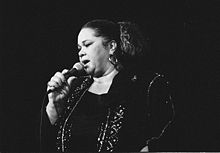 Blues Foundation
Blues Foundation
The members of the Blues Foundation, a non-profit organization set up in Memphis, Tennessee, to foster the blues and its heritage, have nominated James for a Blues Music Award nearly every year since its founding in 1980; and she received some form of Blues Female Artist of the Year award 14 times since 1989, continuously from 1999 to 2007. In addition, the albums Life, Love, & The Blues (1999), Burnin’ Down The House (2003), and Let’s Roll (2004) were awarded Soul/Blues Album of the Year, and in 2001 she was inducted into the Blues Hall of Fame.

